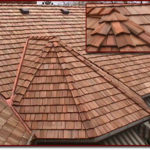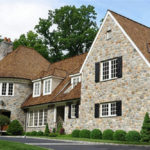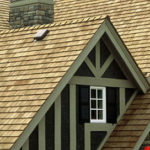CEDAR ROOFING FAQ’S

Cedar roofing adds warmth and elegance, an architectural look that states classic quality, taste and timelessness. Aside from their aesthetic value, products are lightweight, as well as wind and impact resistant. Cedar roofing has been a material used for centuries for two major reasons. First, cedar provides superior insulation. And second, the wood itself contains high amounts of natural preservatives. The presence of these natural preservatives has led cedar roof owners to be confused on how to preserve the cedar roofing. Read below for some frequently asked cedar roofing questions.
Q: Do all exterior wood surfaces, even cedar and red wood, require regular maintenance and treatment ?
A: Yes. While some species of wood are more resistant to decay than others, the natural resins in all species begin to deteriorate after time. This leaves the wood susceptible to moisture, warping and splitting, moss and mildew formation and especially vulnerable to the damaging effects of the sun’s ultraviolet rays.
Q: How about wood pressure-treated at the factory, does it need treatment?
A: Again, yes. Wood that is factory treated with chromated copper arsonate (CCA), has built-in insect and decay protection, but not protection against the effects of water, sunlight, mildew and other aspects of weathering and wear. Recognizable by its familiar green to light brown appearance, most consumers realize that the aesthetic appearance of pressure treated wood is just as important as long-term structural integrity.
Q: When treating exterior wood – whether a deck, fence or roof – isn’t a common water sealer enough?
A: The answer is usually no. Water sealers offer short-term moisture protection only. For long-term protection, a broader based protective treatment is needed. Ideally, that treatment should replenish the wood’s natural resins and rejuvenate its interior properties, include a moss and mildew retardant and, very important, an effective ultraviolet light inhibitor. Consider, too, in the case of fence and roof treatments, the desirability of a color enhance to return the wood to its original, natural appearance.
Q: Are single application treatments available that contain all these protective features?
A: Yes. The following checklist will tell you what to look for when selecting these treatments. Make sure the product is environmentally friendly. Make sure the treatment contains natural resins to penetrate and replenish natural wood oils. Make sure the treatment contains a repellent to seal out rain and other forms of moisture, but still allows the wood to “breathe”, so its protective shield will not crack, peel or blister. Make sure the treatment contains a light pigmentation that will restore the wood surface to its original natural color.
Q: Exactly what is meant by “environmentally friendly”?
A: There are basically two types of exterior cedar roofing preservation treatments available today, those that are potentially hazardous to the environment – containing a hydrocarbon solvent base – and a new generation of treatments that contain little or no such solvents and present no danger.
Q: Exactly when should a new roof first be treated?
A: New roofs, whether constructed from pressure-treated or non-treated lumber, the wood should be allowed to dry for approximately nine months before the first application.
Q: How often should treatment be reapplied?
A: For optimum maintenance and maximum extension of the Cedar roofing life, roofs and fences should be retreated every 3 to 5 years. Decks, with flat surfaces that hold water longer, should be retreated annually.
Q: How about older wood structures already showing signs of deterioration, is it still worth it to treat them.
A: In most cases, the answer is yes. If you have any questions about the wood’s structural integrity or remaining service life, consult a Professional Contractor or Wood Treatment Applicator. The restorative properties of many modern wood treatments, combined with the other maintenance steps outlined elsewhere on this site, can rejuvenate even seriously deteriorating exterior wood structures, extending their natural service lives and significantly enhancing their appearance. With the high cost of lumber today that makes good economic sense, and with the dwindling world forestlands, it makes excellent environmental sense.
Q: Do you offer roof cleaning for asphalt roofing?
A: Yes we do, we offer soft wash pressure washing for driveways, sidewalks, home siding and asphalt roofs. Please see our partner site AmericanWashing.com




